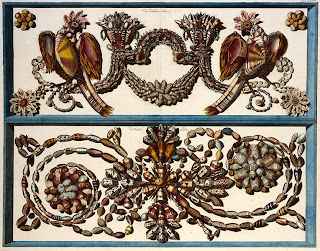
A lecturer of medical pharmacology. Dr. Robert John Thornton's Temple of Flora enlisted the finest British engravers, a project that eventually left him destitute.

Walton Ford rejected the idea of becoming another Audubon; rejecting animal subjects completely. Naturally shot by its naturalist, this flamingo is animal iconography utterly devoid of any sentimentality.
 Arrangements ornementaux et en guirlandes de diverses coquilles de mollusques
Arrangements ornementaux et en guirlandes de diverses coquilles de mollusques
Dutch pharmacist Albertus Seba obtained his specimens from Amsterdam's sailors and ship surgeons.
 Kiki Smith's Constellation and a nod to Curious George
Kiki Smith's Constellation and a nod to Curious George 







10 comments:
I spent the morning before work watching PBS Art:21...Check it out at www.art21.org
Barbara Hodgson's The Sensualist: An Illustrated Novel ?
https://books.google.com/books?id=J2EnDwAAQBAJ&pg=PT11&lpg=PT11&dq=an+asylum+is+like+bottom+of+a+pool+where+all+the+toxins+in+the+human+heart+accumulate.&source=bl&ots=K-GJ-lnseh&sig=ACfU3U0aRhYOnSNeVPNYzr4HdxirCXAyQA&hl=en&sa=X&ved=2ahUKEwjL29Pc74f5AhXgM1kFHUeVA60Q6AF6BAgEEAI#v=onepage&q=an%20asylum%20is%20like%20bottom%20of%20a%20pool%20where%20all%20the%20toxins%20in%20the%20human%20heart%20accumulate.&f=false
"The heart utilizes about 60-70% of generated ATP to fuel contraction and the remaining 30-40% for various ion pumps, especially the Ca2+ -ATPase in the sarcoplasmic reticulum.3, 4 The energy pool of the heart includes ATP (~ 5 μmol/g wet wt) and phosphocreatine (~ 8 μmol/g wet wt) with the latter serving as an ATP transport and buffer system.5 In the mitochondria, the high-energy phosphate bond in ATP can be transferred to creatine by mitochondrial creatine kinase (CK) to form phosphocreatine (PCr). With a smaller molecular weight than ATP, PCr can easily diffuse through the mitochondrial membrane into the cytosol. Here, it can be used to generate ATP from ADP through reactions catalyzed by the cytosolic CK.6 Due to its continuous mechanical work, the heart has a high rate of ATP hydrolysis (~ 0.5 μmol/g wet wt/s). Accordingly, the high-energy-phosphate pool in the heart is relatively small and can be exhausted within a few seconds. Therefore, cardiac work strongly depends on ATP generation and impairments in this process can rapidly induce contractile dysfunction."
https://www.ncbi.nlm.nih.gov/pmc/articles/PMC3896379/
Poison lyrics by Laurie Anderson on Bright Red (1994), Laurie Anderson (2002) ..."A small bullet, a piece of glass. And your heart just grows around it."
https://books.google.com/books?id=2MWREk-rXG0C&pg=PA112&lpg=PA112&dq=Stories+of+the+Invisible+Ball+%22nitrogen+atoms+recombine+to+form+nitrogen+molecules%22&source=bl&ots=mfOn-tqQXW&sig=ACfU3U2iek4Gt2JRSIGpecc0_zbHe3lHuA&hl=en&sa=X&ved=2ahUKEwjF3tWb8of5AhX9FVkFHbSzCUwQ6AF6BAgDEAI#v=onepage&q=Stories%20of%20the%20Invisible%20Ball%20%22nitrogen%20atoms%20recombine%20to%20form%20nitrogen%20molecules%22&f=false
The stress of their household, and the precarious structure holding it in place...One day at a time. My niece starts school one day after her fifth birthday, August 22nd.
Andy, my beloved cat, has congestive heart failure...wasting, dyspnea, and wet lungs. I am supplementing with taurine. He is a finicky eater, and I have been through a regimen of furosemide and diltiazem oral doses twice daily with poor effect.
"Mammalian taurine synthesis occurs in the liver via the cysteine sulfinic acid pathway [BioCyc ID: PWY-5331] from L-cysteine via the action of cysteine dioxygenase (CDO). CDO regulates intracellular cysteine levels, as high levels can be toxic, with low cysteine levels causing degradation of this enzyme and vice versa. The rate limiting step of the taurine synthesis is the enzyme cysteine sulfinic acid decarboxylase (CSAD). Certain animals like mice have a high expression of this enzyme and can synthesize taurine in sufficient quantities provided adequate cysteine in diet. Carnivorous animals like cats and dogs have a lower expression of CSAD and thus require taurine from their diet. Taurine depletion results in cardiomyopathy in these animals."
https://clinmedjournals.org/articles/ijcc/international-journal-of-clinical-cardiology-ijcc-8-246.php?jid=ijcc#:~:text=Several%20clinical%20trials%20have%20shown,patients%20with%20congestive%20heart%20failure.
https://youtu.be/OkM7ws50fzA
I finally saw this, after reading the novel. I gave it to Siena.
Taurine deficiency in early life contributes to midlife cardiomyopathy. I took in one stray with this condition. I took him to a vet, and he precipitously declined with the struggle of medicating him in the last months.
I have Dandelions (1972) next to my bed, still.
Exercise 91.
"The researchers found that the approximately ten thousand spherically domed calcite crystals covering the five limbs and central body of the brittlestar function as micro-lenses. These micro-lenses collect and focus light directly onto nerve bundles that are part of the brittlestar's diffuse nervous system. Remarkably, the brittlestars secrete this crystalline form of calcium carbonate (calcite) and organise it to make the optical arrays. According to Alexei Tkachenko of Bell Laboratories, one of the authors of the study, 'The brittlestar lenses optimize light coming from one direction, and the many arrays of them seem to form a compound eye.'"
https://books.google.com/books?id=l7R3EAAAQBAJ&printsec=frontcover&dq=oceans+syperek+wade&hl=en&newbks=1&newbks_redir=0&source=gb_mobile_search&sa=X&ved=2ahUKEwjqitPt9NCAAxU6kYkEHXpvCFgQ6AF6BAgFEAM#v=onepage&q=oceans%20syperek%20wade&f=false
https://tv24.co.uk/p/all-creatures-great-small-season-5-episode-2-6ilz6z
Except for the rain rot article and the seaweed chutney, all are mentioned in the episode.
https://equisearch.com/horsejournal/fungus-26669/
https://www.tobermoryfish.co.uk/smoked-trout-2/?_gl=1*s03mra*_up*MQ..*_ga*OTk0NzM0LjE3MzE4MTg0MTg.*_ga_L6S9562GV1*MTczMTgxODQxNy4xLjEuMTczMTgxODQ1OS4wLjAuMA..
https://www.tobermoryfish.co.uk/product/isle-of-mull-seaweed-chutney/?_gl=1*jfjmxi*_up*MQ..*_ga*OTk0NzM0LjE3MzE4MTg0MTg.*_ga_L6S9562GV1*MTczMTgxODQxNy4xLjEuMTczMTgxODU1Ny4wLjAuMA..
https://www.criterion.com/films/345-brief-encounter?srsltid=AfmBOooOQ1-kXJIt0rYdTbrTBwG3xO_mOzIedp9UFo-Rc--o69z-IwZP
https://horseracinghof.com/notable-heroes/the-godolphin-arabian/
https://thehorse.com/188864/caring-for-horses-over-30/
There is a place called Gog Magog (!)
https://www.tbheritage.com/TurfHallmarks/Graves/cem/GraveMattersWandlebury.html
https://worldofwork.io/2024/07/leisure-sickness-why-do-i-always-get-sick-when-i-have-time-off-work/#:~:text=Why%20does%20this%20happen?,increases%20their%20levels%20of%20stress.
It has happened, a bit. The fatigue and black hole-bound feelings with not having structure. The chills and body aches now. I am more conscientious with every year. Early to bed now. To work on the Exercise
My mother's sister's birthday was yesterday, and then there was a memorial brunch and dinner she had to arrange for a coworker. I had promised to help. Both activities were good in themselves, but I stopped my reading of the Book of Ruth to enter the social sphere.
The wave of food poisoning/flu-like symptoms that came on the evening of the first day of Shavuot are understood now. I cannot shortchange Hashem. I am feeling better now, but I thought I had a terrible flu. Awful.
https://images.app.goo.gl/hxoq1Kjp7Nwx4jtq6
Post a Comment